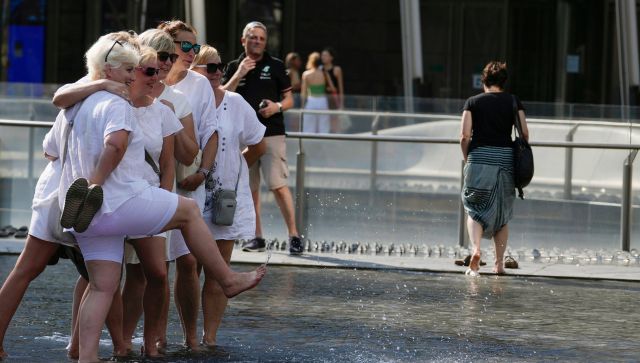A severe heatwave is baking Europe, with several countries reporting temperatures over 40 degrees Celsius. The mercury is expected to soar further across southern Europe in the coming days, meteorologists have warned. Italy, Greece and Spain are among the worst-hit European countries, with reports calling this dangerous heatwave ‘Cerberus’. While heatwaves are not officially named like cyclones and hurricanes, recently monikers have emerged to describe the abnormally high temperatures. Let’s take a look at how sweltering heat is boiling Europe and why some are naming heatwaves now. Heat grips Europe As many as 16 cities in Italy, including Rome, Florence and Bologna, have sounded red alerts. The extreme mercury has made it difficult for tourists to visit crowded places in the country. A 44-year-old road sign worker collapsed and died in Italy’s Lodi town as mercury surpassed 40 degrees Celsius. As per Evening Standard, authorities attributed his death to the extreme heatwave. In August 2021, Italy’s Sicily had recorded Europe’s highest-ever temperature at 48.8 degrees Celsius. Greece shut its famous Acropolis in Athens between midday and early evening hours amid scorching heat on Friday. The country has taken measures to tackle the rising temperatures by changing its public sector working hours and opening up air-conditioned areas to the public, reported Evening Standard. [caption id=“attachment_12877902” align=“alignnone” width=“640”] Forest firefighters douse the blaze on the Canary Island of La Palma, Spain on 16 July. Reuters[/caption] Firefighters on the Spanish island of La Palma blamed intense heat and winds for the raging forest fire. Thousands of people had to be evacuated due to the blaze, reported Reuters.
Forest firefighters douse the blaze on the Canary Island of La Palma, Spain on 16 July. Reuters[/caption] Firefighters on the Spanish island of La Palma blamed intense heat and winds for the raging forest fire. Thousands of people had to be evacuated due to the blaze, reported Reuters.
On Wednesday, the temperature in the southeastern town of Albox in Spain hit a record high of 45 degrees Celsius.
Europe is preparing for a “severe heat storm” with a second heatwave, named Charon, predicted to dial up the temperatures again. Christening heatwaves As per Time magazine, countries use the term heatwave to describe time periods with temperatures more than the average. The heatwave that gripped Europe in 2017 was widely called Lucifer, the name for the devil in Christianity and a name for the planet Venus in Roman myth reported Wired. Last August, the Spanish city of Seville said it was the “first in the world” to name a heatwave. On the first day of summer last year, the city rolled out its first ranking and naming system, which consisted of dividing heatwaves into three tiers depending on their impact on health, according to Canada’s Global News. As the naming system runs in reverse alphabetical order, ‘Zoe’ became the first name for a heatwave christened in Seville. “Extreme heatwaves are becoming more frequent and devastating as a direct effect of climate change. Seville is proud to become the first city in the world to develop and implement a heatwave naming and categorisation system that aims at saving thousands of lives and we encourage other cities in the world to also undertake this great endeavor,” Seville’s former mayor, Juan Espadas, said in a statement in 2021. In June last year, Los Angeles, Miami, Milwaukee, Missouri’s Kansas City and Athens also decided to categorise heatwaves on the basis of weather data and public health criteria. The heatwave affecting Europe last week was named Cerberus , a three-headed dog that guarded the underworld in Greek mythology. Italian Meteorological Society has cleared it is not behind this sobriquet. As per Wired, the name was chosen by the Italian weather website iLMeteo, which is known for naming anticyclones, or high-pressure regions, after mythological figures.
It must be noted that the World Meteorological Organization (WMO) does not give official names to heatwaves presently.
Cerberus heatwave is being referred to as Xenia in Seville. Petra Gebauer, chair of Berliner Wetterkarte – a meteorological nonprofit – told Wired that the heatwave in southern Europe is being called Cleon in Greece. [caption id=“attachment_12877922” align=“alignnone” width=“640”] Tourists cool off in a public fountain in Milan, Italy on 15 July amid a heatwave. AP[/caption] According to Wired, iLMeteo will call the next heatwave Caronte or Charon – a reference to the boatman who ferries souls of the dead to the Greek underworld. ALSO READ:
Heat is On: How 3 July becomes the world’s hottest day and the worst is yet to come
Why are heatwaves being named? Kathy Baughman McLeod, senior vice president and director of the Atlantic Council’s Adrienne Arsht-Rockefeller Foundation Resilience Center, which helped design Seville’s system argued earlier that naming heatwaves will create a “culture of awareness”. “Heatwaves have been dubbed ‘the silent killer’ for a reason: They wreak unseen havoc on our economies, prey on the most vulnerable members of society, and kill more people than any other climate-driven hazard,” she said in a statement in October 2021. “Yet the dangers they pose are grossly underestimated and gravely misunderstood.” Speaking to Observer in 2021, Kostas Lagouvardos, research director at the National Observatory of Athens, said: “We believe people will be more prepared to face an upcoming weather event when the event has a name”. “They’ll become more aware of the possible problems it could cause to their lives and to their properties.” Concern about naming heatwaves Some argue that giving well-known fearsome names to cyclones will only spread panic among the public. “We’re going to run out of dangerous monsters quite quickly,” Hannah Cloke at the University of Reading told Wired, adding that people will become desensitised to this method. “In the longer term, it’s not ideal”, she added. Cloke suggested simple names, such as those used for storms, may be more effective in raising awareness about a weather event. With inputs from agencies
Tourists cool off in a public fountain in Milan, Italy on 15 July amid a heatwave. AP[/caption] According to Wired, iLMeteo will call the next heatwave Caronte or Charon – a reference to the boatman who ferries souls of the dead to the Greek underworld. ALSO READ:
Heat is On: How 3 July becomes the world’s hottest day and the worst is yet to come
Why are heatwaves being named? Kathy Baughman McLeod, senior vice president and director of the Atlantic Council’s Adrienne Arsht-Rockefeller Foundation Resilience Center, which helped design Seville’s system argued earlier that naming heatwaves will create a “culture of awareness”. “Heatwaves have been dubbed ‘the silent killer’ for a reason: They wreak unseen havoc on our economies, prey on the most vulnerable members of society, and kill more people than any other climate-driven hazard,” she said in a statement in October 2021. “Yet the dangers they pose are grossly underestimated and gravely misunderstood.” Speaking to Observer in 2021, Kostas Lagouvardos, research director at the National Observatory of Athens, said: “We believe people will be more prepared to face an upcoming weather event when the event has a name”. “They’ll become more aware of the possible problems it could cause to their lives and to their properties.” Concern about naming heatwaves Some argue that giving well-known fearsome names to cyclones will only spread panic among the public. “We’re going to run out of dangerous monsters quite quickly,” Hannah Cloke at the University of Reading told Wired, adding that people will become desensitised to this method. “In the longer term, it’s not ideal”, she added. Cloke suggested simple names, such as those used for storms, may be more effective in raising awareness about a weather event. With inputs from agencies
)